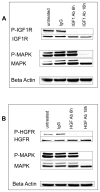Comprehensive analysis of receptor tyrosine kinase activation in human melanomas reveals autocrine signaling through IGF-1R
- PMID: 21654344
- PMCID: PMC3131461
- DOI: 10.1097/CMR.0b013e328343a1d6
Comprehensive analysis of receptor tyrosine kinase activation in human melanomas reveals autocrine signaling through IGF-1R
Abstract
Melanomas depend on autocrine signals for proliferation and survival; however, no systematic screen of known receptor tyrosine kinases (RTKs) has been performed to identify which autocrine signaling pathways are activated in melanoma. Here, we performed a comprehensive analysis of 42 RTKs in six individual human melanoma tumor specimens as well as 17 melanoma cell lines, some of which were derived from the tumor specimens. We identified five RTKs that were active in almost every one of the melanoma tissue specimens and cell lines, including two previously unreported receptors, insulin-like growth factor receptor 1 (IGF-1R) and macrophage-stimulating protein receptor (MSPR), in addition to three receptors (vascular endothelial growth factor receptor, fibroblast growth factor receptor, and hepatocyte growth factor receptor) known to be autocrine activated in melanoma. We show, by quantitative real time PCR, that all melanoma cell lines expressed genes for the RTK ligands such as HGF, IGF-1, and MSP. Addition of antibodies to either IGF-1 or HGF, but not to MSP, to the culture medium blocked melanoma cell proliferation, and even caused net loss of melanoma cells. Antibody addition deactivated IGF-1R and hepatocyte growth factor receptors, as well as mitogen-activated protein kinase signaling. Thus, IGF-1 is a new growth factor for autocrine driven proliferation of human melanoma in vitro. Our results suggest that IGF-1-IGF-1R autocrine pathway in melanoma is a possible target for therapy in human melanomas.
Figures






References
-
- Balch CM, Buzaid AC, Soong SJ, Atkins MB, Cascinelli N, Coit DG, et al. Final version of the American Joint Committee on Cancer staging system for cutaneous melanoma. J Clin Oncol. 2001;19(16):3635–48. - PubMed
-
- Kirkwood JM, Manola J, Ibrahim J, Sondak V, Ernstoff MS, Rao U. A pooled analysis of eastern cooperative oncology group and intergroup trials of adjuvant high-dose interferon for melanoma. Clin Cancer Res. 2004;10(5):1670–7. - PubMed
-
- Lazar-Molnar E, Hegyesi H, Toth S, Falus A. Autocrine and paracrine regulation by cytokines and growth factors in melanoma. Cytokine. 2000;12(6):547–54. - PubMed
-
- Albino AP. The role of oncogenes and growth factors in progressive melanoma-genesis. Pigment Cell Res. 1992;(Suppl 2):199–218. - PubMed
-
- Shih IM, Herlyn M. Autocrine and paracrine roles for growth factors in melanoma. In Vivo. 1994;8(1):113–23. - PubMed
Publication types
MeSH terms
Substances
Grants and funding
LinkOut - more resources
Full Text Sources
Medical
Research Materials
Miscellaneous

